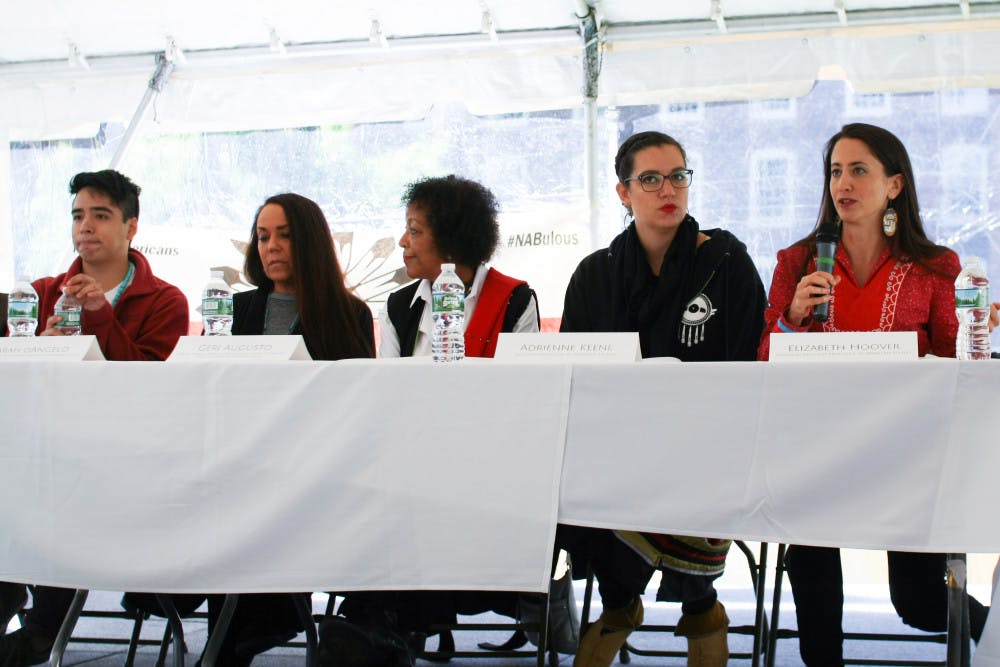The Native American and Indigenous Studies at Brown initiative, which was launched last spring, is now searching for a director, wrote Provost Richard Locke in an email to The Herald.
The group, which consists of 22 faculty members and postdoctoral fellows from across the American studies, history, anthropology, religious studies, archaeology, environmental studies, linguistics, music and theatre arts and performance studies departments, has been working on the project since winter 2015. A list of courses included in the initiative was recently released.
The working group behind the initiative consolidated relevant classes that already existed — covering topics including American Indian history, environmental health in Native communities and the history of interactions between Native and European people — and hopes to create new courses, said Mark Cladis, professor and chair of the department of religious studies.
Before the initiative began, the University offered courses in these topics, but the courses were “spread out throughout the curriculum so it wasn’t clear what was being taught systematically, and it wasn’t clear what wasn’t being taught,” Cladis said.
The initiative emphasizes “certain pressing issues that confront Native American and indigenous communities and (tries) to bring those issues more to the fore in terms of the attention of Brown, to the area and nationally,” Cladis said.
“It was through years of pressure from the indigenous student and faculty community that (this community) influenced the shaping of this new program,” wrote Ruth Miller ’19, co-coordinator of Native Americans at Brown, in an email to The Herald. She added that there is indigenous representation in the faculty and staff within the initiative and that Niyolpaqui Moraza-Keeswood ’16 acts as a coordinator between the initiative and Native Americans at Brown.
“Many constructive ideas were advanced by actively engaged students and faculty in conversation with President (Christina) Paxson (P’19) and me during the development of the University’s Pathways to Diversity and Inclusion action plan, which led to the focused planning effort,” Locke wrote. “The NAIS(AB) initiative was developed in conjunction with our DIAP efforts, and it is incorporated into the DIAP’s academic programming objectives.” The Academic Priorities Committee reviewed the plan, and he and Paxson approved it, Locke added.
“A great university that’s situated in New England must have a program about Native American studies,” said Geri Augusto, visiting associate professor of international and public affairs and Africana studies. “If not, there’s a great big hole.”
“I’m hoping we can use indigenous and Native American knowledge studies as intellectual resources for all the big questions we are always thinking about” on issues of the environment, race relations, political sovereignty and individual identity, Augusto said, adding that the NAISAB initiative “could contribute a lot to research, to teaching and to reflection.”
“Indigenous expression and ways of knowing have been historically excluded from mainstream artistic and educational institutions,” wrote Sarah dAngelo, assistant professor of theatre arts and performance studies. “It is encouraging that Brown University is among the few institutions in the United States who recognize (that) indigenous systems of knowledge and creation bring great value to its curriculum and demonstrates a commitment to diverse perspectives and lifeways.”
Once established, the program would be of interest not only for students who want to study a certain Native American population but also for those interested in philosophy, politics and the environment, Augusto said.
“The plan envisions the development of, among other things, an interdisciplinary NAIS(AB) curriculum, new research initiatives and new engaged scholarship opportunities,” Locke wrote. “Intellectually, an important goal is to promote the incorporation of Native and indigenous knowledge and perspectives in teaching and scholarship across the breadth of the campus. Institutionally, the ambition is for the initiative to be a first step toward establishing a program or center.”
The initiative hopes to support postdoctoral researchers, bring on a director and even offer an undergraduate concentration in the future, Cladis said. Faculty members are currently looking into how to build momentum, advertise their courses and determine what courses should be taught, he added.
“Institutional issues are not the heart of a movement or a program, but if those aren’t in place it is hard to have longevity,” Cladis said.
Cladis’ course “RELS0260: Religion Gone Wild: Spirituality and the Environment” is included in the NAISAB initiative course list. It is about relationships between humans and the natural world, focusing on Australian aboriginal and Native American approaches to interacting with their environments. He hopes to add a course on Native American religions but is unsure of when exactly it will materialize, he added.
Cladis got involved with the initiative about two and a half years ago when an email was circulated asking if any faculty members would be interested in joining, and from there, “It grew organically,” he said.
Augusto was also a part of the working groups that came up with the concept and proposal for how NAISAB would work at the University, she said. “What drew me to this field (was) my interest in ways of knowing and ways of being,” Augusto said, explaining that she has a passion for “epistemology and ontologies” — how knowledge is produced and pertains to power and conflict. “I’m interested in the dynamic between indigenous knowledges and other types of knowledges, and that’s what led me to this,” she added.





